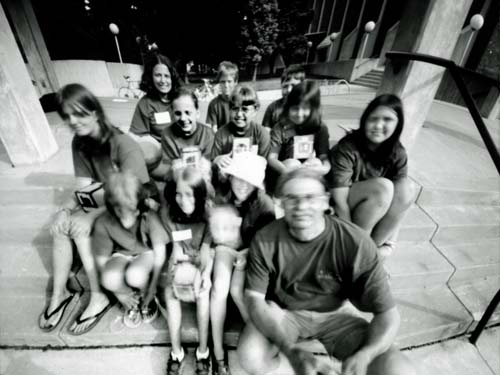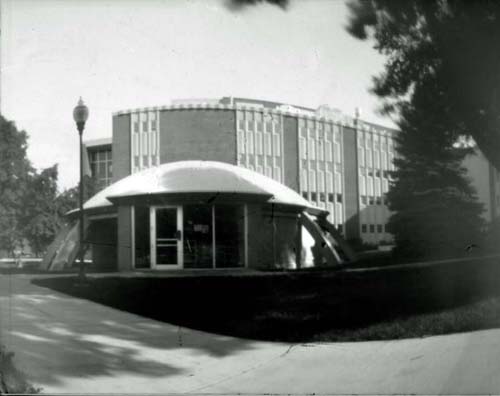In the mid-90s, Race Office & Art Supply closed their retail store on Main Street. In their clearance sale, they had three rolls of 1 inch x 60 yard 3M #235 Opaque Photographic Tape for a dollar apiece. I snapped them up. There are still about a third of two rolls left. I used it to make darn sure Little Guinness was reliably light tight. Coincidentally, Camera Casino is now in that store.
Shortly after loading the camera, I achieved a goal I had been pursuing for years. Stewart is a typical sun-loving cat but he can hear a tripod coming from across the house. One morning he was obviously concentrating on chasing mousies in his sleep with an occasional twitch of his legs and extension of his claws. I approached as near as I dared, made as few adjustments to the tripod as possible and opened the shutter for a one minute exposure.
Unbelievably, no response to this. I boldly approached and readjusted the tripod. When I closed the shutter and wound the film he drowsily looked up and took off like a shot.
I had much better cooperation from the squirrel on the table.
Uh-oh! The police responded to an expletive-laden shouting match between a young couple a few doors down and across the street and they parked in front of our house!
A week or so before we had gone to Appleton to pick up my photo
that had been in a juried show. We had lunch at Fratello's Waterfront Restaurant in a repurposed factory with its giant windows and panoramic views of the rapids and the dam over the Fox. I didn't have a camera with me but I was so taken by the scene that I went back with Little Guinness. They also have a
restaurant on the Fox in Oshkosh with the same undistinguished menu but the building is new and the river isn't as dramatic upstream from Lake Winnebago.
The main gallery held an exhibit of pieces by local artists who had been commissioned by patrons of the museum. I had noticed in the juried show that some of the works had a statement that this artist was accepting commissions. Nobody asked me if I wanted to accept commissions.
We had recently ordered a footstool that turned out to be way out of scale for our modest bungalow. We could avoid repackaging it if we returned it in person at Marshalls in Appleton. The carton wouldn't fit in the Mustang but they didn't seem to mind taking it back without it. It took two clerks and a supervisor some time to figure out how to code a return of an on-line purchase so there was plenty of time for an exposure.
While we were there we took the opportunity for some Halloween hunting.
One place we hadn't planned on going was Kohl's. Sarah had seen a door mat on-line she was interested in but we hadn't looked up where it was until I took a wrong turn and we drove right up to it.
It's pretty easy to unobtrusively place a little box made from packaging on the shelves among the merchandise. Several shoppers looked at this little haunted house without noticing the camera sitting right in front of it.
We enjoyed our little day trip so much, we went back a week later. The Fox descends about 160 feet between Lake Winnebago and Green Bay. The river was lined with factories taking advantage of the falling water. In Appleton where the largest of the falls was, they've done a particularly good job of restoring and repurposing a lot of these mills. This one is right next to Fratello's. Just behind the tree is
another smashing little restaurant, The River Tyme Bistro.
We were seated next to a large window in the shade of the tree. The decorating includes random artifacts casually placed around the room.

Just behind me was a little conversation nook with a microscope on the coffee table.
Unfortunately we were sitting in a largely empty dining room where to the left of the frame it looked like they were setting up for some kind of children's party. To the right there were about 25 well-appointed women at a meeting of a fund raising organization for abused women. They were watching a video of a cavalcade of speakers with the audio playing through what sounded like a pocket transister radio from the '60s. It kept going for the entire time we were there and some of the ladies looked a little envious when we left.
Just up the hill is a historic house that somehow we had never been aware of. It's the first house in the world to be electrified by hydro-electric power. It would have been the first house connected to an electrical distribution system rather than by it's own generator, but Edison wouldn't license them the technology until he had one set up in New York.
It was a very nice tour. No velvet ropes and lots of references to everyday sayings that trace back to the technology of the late 19th century. Most of the historic houses I've seen have converted the kitchen to offices or galleries, but this one was restored and still used to cater events.
There was only one other person on the tour and it was very friendly and personable. Sarah chatted with the docent while I took pictures on the porch.
The entire time the docent watched me and I even got involved in the conversation a few times, but he never mentioned anything about my cardboard camera.
We then drove down river to Little Chute. Just after the turn of the millenium, the city elders decided they needed to celebrate the Dutch heritage of the town and commissioned a full-sized, working windmill to be constructed in the Netherlands which was disassembled and reconstructed on the Fox in the middle of down town.
Little Guinness chalked up another notable feat when I went for the backlighting and captured the famous black hole sun effect, where it's
so overexposed it gets solarized.
Little Guinness has a .17mm hand-drilled pinhole 24mm from a 24x36mm frame - and no light leaks. Kodacolor 200.
Tripodology Note: I took about half of these with the little gag tripod Promaster sells for keychains.


























































